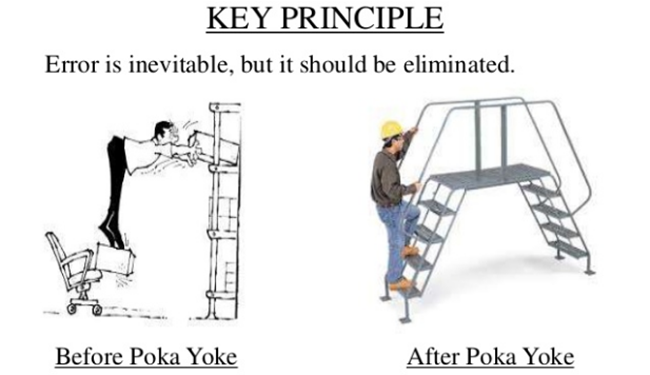While the adoption of Toyota’s Lean Manufacturing principles have introduced words and phrases such as “Kaizen” and ‘the Seven Wastes” into everyday conversation, mention “Poka Yoke” and you will probably get blank looks. Yet using a Poka-Yoke principle is a powerful and proactive way of minimizing human error and reducing defect as a result. Poka Yoke is one of the methods and tools of Jidoka, which translates into “intelligent automation”, or the word coined as a direct translation “automation”. Jidoka addresses the quality of production, ensuring that a consistent quality is maintained during manufacturing by the identification, with instant mitigation and removal of activities that lead to defects in the finished product. While Jidoka tends to be neglected by many proponents of Lean, one of the tools is used widely, namely the “5 whys” or root cause analysis. Jidoka was said to have been designed in 1896 by Sakichi Toyoda. Fundamentally, an automatic stop was built into a mechanical loom that immobilized the shuttle if the thread being spun snapped. The operator would be notified by a flashing light (“Andon” or “lamp” in Japanese) that there was a failure to which he could attend. Apart from improving the process, this small adjustment also greatly improved efficiency, because one operator could now oversee more than one machine.
To Error is Human
The chief principle of Jidoka, as part of the Toyota Production System (TPS) is that no defective products must roll off the assembly line, because they are “waste” (“Muda” in Japanese). This thinking was radically different from what most manufacturers practiced at the time. It was expected that there would be a percentage of items produced that were defective and would be discarded. Poka Yoke principle was a further refinement to Jidoka, conceived by Dr Shigeo Shingo as part of his Zero Quality Control program in the 1980’s. He observed that where there was a human involved in an activity, there was a chance that the operator could make a mistake, eventually resulting in a defect. In order to minimize or prevent this happening, it was necessary to implement some type of constraint, in the form of a physical or electronic device. The concept is not new, for instance, in 1850 Margaret Knight invented a stop mechanism for looms to prevent worker accidents. However Dr Shingo identified possible causes of failure through human error and developed the concept Poka Yoke, which means “mistake proofing”.
Preventing Errors Reduces Defects
A mistake or error in production is to be expected where humans are involved, as humans are fallible. Mistakes can be corrected during the production process. If this is not done, it results in a defect in the finished product. If all the possible chances for human error are removed from the process, there will be little or no defect. Introducing a Poka Yoke at the potential point of failure will mitigate or avoid the error. For example, a USB port will only accept a USB connector the right way up, and an automatic car can only be started in Park or Neutral. Although there are many ways to implement a Poka Yoke, there are basically only two types of devices:
- Warning, a buzzer or a bell makes a sound, and/or a light flashes to bring attention to the mistake. This is a detection device – the error has occurred.
- Control – whatever activity is in progress is stopped and the mistake has to be corrected. This is a prediction device – the error will occur if remedial action is not taken immediately.
Some Benefits of Applying Poka Yoke
While the obvious reason for applying Poka Yoke principle is the quality of what is produced, there are other benefits.
- Workers will need less training, because the process they are now following will automatically correct any deviation from what is required.
- Increased safety where work is done with hazardous materials or in risky conditions, such as working with electricity or petrochemicals.
- quality checks by sampling and inspection can be reduced, because the elimination of mistakes is built into the process, either b prediction or by detection
- the work will be less repetitive and boring because of the removal of some of the inspection that was needed before
- Quality-based work and continuous improvement become a way of life.
- No defective items, or very few, are produced, thus reducing waste and costs
- Confidence levels in the product(s) are improved, because stakeholders know that the production process eliminates or radically reduces defects being produced.
The Poka Yoke principle is proactive, in that the risk of error is anticipated and mechanisms are put in place before the potential error occurs. Mistakes can still happen, but they are minimal.
Using Poka Yoke principle in other industries
While Poka Yoke was designed with manufacture in mind, it can also be used in service industries to improve customer experience and customer-facing processes. The Poka Yoke principle has also found favor in IT where agile development is practiced – a method called “test-driven design” (or TDD). This requires the test to be written before any code is developed.
We are protected by Poka Yoke in our daily lives too, only we are not aware of it. Every time we use a three-point plug, insert a sim card in our phone, or change into a reverse gear, we are protected by a poke-yoke that does not permit us to do any of these things incorrectly.
These interventions that make our lives safer by preventing mistakes are usually inexpensive and unobtrusive and most of us are unaware that they have been designed into the way we work and play.






